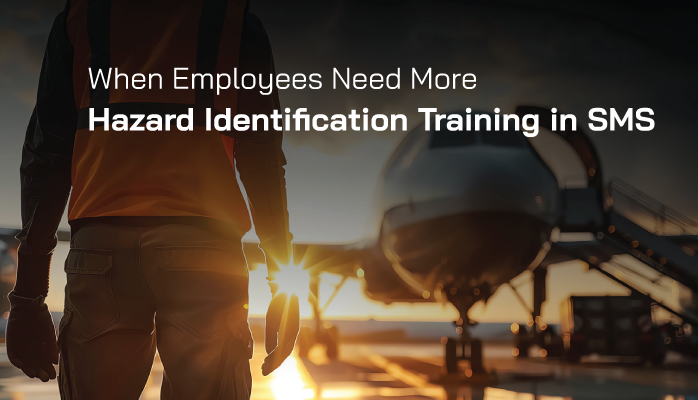Misconceptions About Hazard Identification Training in SMS

Hazard Identification Training is not just for aviation safety officers.
Every area of an organization is exposed to different types of hazards, including, but not limited to:
- Chemicals;
- Electrical hazards;
- Moving equipment; and
- Untrained personnel.
Therefore, each area of an organization benefits from reduced risk from hazard identification training.
Does your company personnel need more or better hazard identification training? How can you tell?
Hazard identification training guides all participants in an aviation safety management system (SMS) on what they need to be doing to keep risk as low as reasonably practical (ALARP). Furthermore, training is also useful to promote transparency within the organization by demonstrating risk management processes practiced by the safety department. For example:
- Front-line employees identify and distinguish between hazards, threats, risks, consequences, and impacts in the operating environment;
- Safety managers perform risk analysis, make safety-data based decisions, implement the SMS, and drive compliance; and
- Upper management distinguishes threats, risks, and impacts in the corporate environment, and dictates performance vs preparedness pressures.
It’s often an unfortunate misconception that hazard identification and risk management training is only for safety managers. When this happens, front-line employees are relegated to other types of training that barely touch on identifying hazards and subsequent risk management strategies.
Hazard identification and reporting these identified hazards is the responsibility of every employee in a company. Here are 4 signs that your company personnel require hazard identification training.
1 – Employees Not Received Hazard Identification Training
The most obvious sign that employees need additional hazard identification training is if management under-values hazard identification. This becomes obvious when management has neglected the promotion of the importance of front-line employees identifying hazards and promptly reporting "suspected" hazards within the scope of aviation operations. Some questions to consider:
- Have most employees received specific training on how to identify hazards and what to do when a hazard is discovered?
- Are employees only receiving hazard training second-hand, such as from a safety manager who received the training?
- Are employees having trouble with reporting valid safety concerns?
Answers to these questions make it clear whether employees need more training. Even if employees have received some risk management training, if that training was second-hand or if they are having trouble reporting valid issues, then it’s a good indication that the training was insufficient.
Have You Read
- How to Identify Hazards & Assess Risks in Aviation SMS - With Free Resources
- From Reactive to Proactive Hazard Identification in Aviation SMS
- Automate Aviation Safety Training for Initial/Recurrent Requirements (Free Resources)
2 – You Have an Aviation SMS
It seems slightly “tongue-in-cheek” to say that having an SMS is a sign that employees require training on identifying workplace hazards. However, you might be surprised how often employees and management have an attitude of:
- I don’t need hazard training because I already “know it” or “learned it”;
- Employees don’t need any sort of risk management training because they are not managers;
- There are more important training types needed – such as job skills training; and
- Identifying hazards is about common sense and experience (training isn’t absolutely necessary).
Training to identify hazards in the workplace has little to do with what position you have in the company or what your educational background or experience is. The basic fact is that if you are working in an environment that has an aviation SMS, employees need specific training on how to identify and report hazards commensurate with their position within the organization. Period.
3 – You Still Get Confused During Risk Analysis

I was attending a training about a year ago when an interesting problem arose regarding risk assessments. I was in a room with several other aviation safety officers and safety professionals, and they could not come to a consensus about what is a hazard and what is a risk. This happens more frequently than one would expect.
It highlighted the fact that in risk management, it’s easy to take knowledge for granted. When this happens, we assume that we know things that we actually don’t have a clear understanding of. This becomes obvious when we have to try and explain a concept, such as "What is a hazard?"
Confusion and exposed assumptions need to be carefully monitored. They are the clearest sign that employees need further training. Another classic example of this is frequent confusion among safety officers for common terms that we use daily:
- Hazards;
- Risk;
- Undesirable consequences; and
- Impacts.
When safety managers are not absolutely clear about what hazards and risks are, it is highly likely that most of the employees also share in the confusion.
I’ve been guilty of it, and so have you (I'm not perfect, yet). We see this confusion happen constantly among aviation safety professionals. Yet it’s critical to all safety-sensitive aviation operations that managers have a clear understanding of how each of the above items fits into risk management architecture.
Can you describe and identify the difference between hazards, risks, and impacts? If not, do you think all employees know how to identify a potential hazard when they see it? And if they can identify the hazard, are you certain they know the process to report the hazard?
Have You Read
- Difference Between Hazards, Risks & Control Measures in Aviation SMS
- 4 Pillars | What Is Hazard Identification in Aviation SMS
- 4 Tips to Approach Hazard Identification in Aviation SMS
4 – No Pre/End-of-Course Assessments in Previous Training
Not having an end-of-course assessment for hazard identification training is a huge red flag for:
- You as the person receiving the training; and
- You as a manager make sure that the training is effective for employees.
End-of-course assessments are a litmus test for how effective the training was. Yet many training courses feature no knowledge tests. The other important thing to consider here is pre-course assessments as well. Pre-course assessments give context and a point of reference for end-of-course testing. Using both types of assessment tells you:
- How well students understood hazard-related topics going into the course;
- How well students understood the topics covered in the course; and
- How well students improved their ability to identify hazards as a result of the course.
If your previous SMS training did not feature specific hazard identification topics with assessments before and after the course, you have no objective way of measuring whether or not the training was worthwhile. If this describes your experience, then training employees using pre-and-post assessments should be beneficial in reducing risk to your organization. As a safety professional, it is your responsibility that employees know how to identify and report hazards.
Final Thought: Indicators of Quality Hazard Identification Training
When you are looking at SMS training courses and are trying to decide which training program to use, here are several things to look out for:
- the course features pre and post-course assessment testing;
- If you have already completed the pre/post testing, your improvement was significant;
- The course was less “listening to instruction” and more “hands-on activities”;
- The course was less conceptual and definitions-based, and more practical application-based;
- The course features a certification – i.e., you receive a certificate for specific risk management topics; and
- You go home with resources to refer back to, and not just a stack of your notes.
In conclusion, I purposely omitted the benefits of hazard identification training because they should be obvious. Your safety culture needs significant improvement when you have employees either:
- Not knowing their duty to report hazards; or
- Ignoring hazards, or
- Not having skills to identify potential safety concerns; or
- Not knowing how to report safety hazards.
How do you ensure all employees can recognize a hazard in their assigned area of operations?
This list of hazards is useful to share with employees. Don't give it to them all at once. You may consider adding a section in your SMS newsletter describing what is a hazard and give them some examples.
Last updated January 2025.






